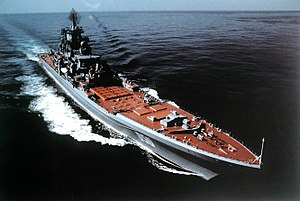
Back كيروف (فئة طراد) Arabic Крайцери проект 1144 Bulgarian Projekt 1144.2 Czech Kirov-klassen Danish Projekt 1144 German Clase Kírov (1980) Spanish Kirov-klassi ristleja Estonian رزمناو کلاس کیروف Persian Orlan-luokan taisteluristeilijä Finnish Classe Kirov (1977) French
 Kirov-class battlecruiser Frunze
| |
| Class overview | |
|---|---|
| Name | Kirov class |
| Builders | Baltic Shipyard, Leningrad |
| Operators | |
| Preceded by | Kara class |
| Succeeded by | Lider class |
| Built | 1974–1998 |
| In service | 1980–present |
| Planned | 5 |
| Completed | 4 |
| Cancelled | 1 |
| Active | 1 (1 undergoing refit) |
| Retired | 2 |
| General characteristics | |
| Type | Heavy guided-missile cruiser/battlecruiser |
| Displacement |
|
| Length | 252 m (827 ft) |
| Beam | 28.5 m (94 ft) |
| Draft | 9.1 m (30 ft) |
| Propulsion |
|
| Speed | 32 knots (59 km/h; 37 mph) |
| Range |
|
| Complement | 710 |
| Sensors and processing systems |
|
| Electronic warfare & decoys | 2 × PK-2 Decoy dispensers (400 rockets) |
| Armament |
|
| Armour | 76 mm plating around reactor compartment, light splinter protection |
| Aircraft carried | 3 helicopters |
| Aviation facilities | Below-deck hangar |
The Kirov class, Soviet designation Project 1144 Orlan (Russian: Орлан, lit. 'sea eagle'), is a class of nuclear-powered guided-missile heavy cruisers of the Soviet Navy and Russian Navy, the largest and heaviest surface combatant warships (i.e. not an aircraft carrier or amphibious assault ship) in operation in the world. Among modern warships, they are second in size only to large aircraft carriers; they are similar in size to a World War I-era battleship. Defence commentators in the West often refer to these ships as battlecruisers – due to their size and general appearance.[3] The Soviet classification of the ship-type is "heavy nuclear-powered guided-missile cruiser" (Russian: тяжёлый атомный ракетный крейсер).
The appearance of the Kirov class (first exemplar commissioned in 1979) played a key role in the recommissioning of the Iowa-class battleships by the United States Navy in the 1980s.[4][5][6]
The Kirov class hull-design was also used for the Soviet nuclear-powered command and control ship SSV-33 Ural.
- ^ "Kirov (Orlan) Class (Type 1144.1/1144.2) (CGN)". Jane's. 8 September 2000. Archived from the original on 15 April 2009.
- ^ a b c Cite error: The named reference
rian20120920was invoked but never defined (see the help page). - ^ Armi da guerra, De Agostini, Novara, 1985.
- ^ Middleton, Drew (13 March 1981). "Pentagon likes budget proposal, but questions specifics". The New York Times. p. A14.
- ^ Bishop, p. 80.
- ^ Miller & Miller, p. 114.